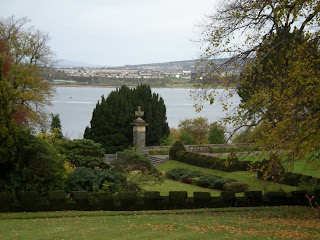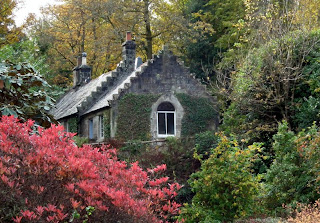Search This Blog
Showing posts with label Buildings. Show all posts
Showing posts with label Buildings. Show all posts
Monday 19 September 2022
Clydeside Distillery
The Pumphouse was built in 1877 to provide hydraulic power for Queen's Dock, the building is now used as a whisky distillery.
Tuesday 30 August 2022
Govan Graving Dock
Three dry docks were built for the Clyde Navigation Trust between 1869 and 1898, the first dock opening in 1875, the second larger dock in 1886 and the third and largest in 1898. They were extensively used for winter overhauls and refits of Clyde steamers.
The Graving Docks were closed in 1988.
Tuesday 7 March 2017
Wednesday 4 March 2015
Finlaystone Estate
 Finlaystone Estate as the first snowdrops make their appearance as the winter months come to an end, clumps of white amongst the dead and rotten foliage of the previous year, crisp white snowdrops to start things off, soon we will have blue bells and the daffodils and spring will be with us once more.
Finlaystone Estate as the first snowdrops make their appearance as the winter months come to an end, clumps of white amongst the dead and rotten foliage of the previous year, crisp white snowdrops to start things off, soon we will have blue bells and the daffodils and spring will be with us once more. Thursday 19 February 2015
Friday 18 July 2014
Highland Mary Dunoon.
Highland Mary or Mary Campbell a lover of Robert Burns,she inspired him to pen a few songs and poems.In my humble opinion she is not worthy of a statue in such a loveley place.
Friday 25 October 2013
Rosneath Naval Base
The base began as a secret operation in July 1941, when civilian workers were sent from America to carry out preparatory work on the site at a time when America was still neutral. The need for secrecy ended unexpectedly on December 7, 1941, when the Japanese Empire attacked Pearl Harbour. Funding for construction of the base was to be provided by both the British and the American governments, in accordance with Lend Lease agreements reached in March 1941, which gave the USA the right to set up shore bases in exchange for warships and supplies. On completion, the base was initially used by the Royal Navy for the repair and maintenance of Atlantic convoy support vessels. In 1942, the Americans took control, and the base became a training centre for amphibious operations in advance of the attack on north west Africa, Operation Torch. In the nearby woods at Greenisle, camps provided accommodation for some 6,000 men. With this operation completed, the Americans returned the base to the Royal Navy, while still retaining a number of areas for use by United States Navy operations: Clachan House, Seabee (Construction Battalions of the United States Navy) base; docking for the submarine depot ship USS Beaver; the boats of Submarine Squadron 50 and the Portkil hospital complex. In preparation for D-Day, the Americans once again took control of the base, in August 1943, for preparatory operations. In June, 1945, the Americans de-commissioned the base, and control finally returned to the British Navy. In 1946, proposals to use the base as a Combined Operations facility were cancelled, and by 1948 the base was closed.
Thanks to Secret Scotland for information.
Sunday 22 September 2013
Sunday 24 February 2013
Glasgow Tower is a free-standing tower located on the south bank of the River Clyde in Glasgow, Scotland and forms part of Glasgow Science Centre complex. It holds a Guinness World Record for being the tallest tower in the world in which the whole structure is capable of rotating 360 degrees.
Overall the structure has been a total disaster,as it has never worked properly since its opening,it has been unused for a number of years.
Monday 11 February 2013
Finlaystone House
Finlaystone House is a
mansion and estate that lies close to the village of Langbank on the south side
of the Clyde..
Finlaystone was a property of
the Dennistoun family, and passed to the Cunninghams in the 15th century. It
was the seat of the Earl of Glencairn until 1796, and is now the property of
the Chief of Clan MacMillan. The house is protected as a category A listed
building, and the grounds are included in the Inventory of Gardens and Designed
Landscapes in Scotland, the national listing of significant gardens.
In the late 14th century,
King Robert II confirmed a grant of the lands of Finlaystone to Sir John de
Danyelstoun (Dennistoun). He was succeeded by his son, Sir Robert, who was
keeper of Dumbarton Castle. When he died in 1399 his estates were divided
between his daughters. Elizabeth inherited Newark Castle, while Margaret
inherited Finlaystone. In 1405 Margaret married Sir William Cunningham, whose
family held the estate as the seat of Clan Cunningham until the 19th century.
William's grandson Alexander Lord Kilmaurs (1426–1488) was created Earl of
Glencairn in 1488. The family were supporters of the Scottish Reformation,
hosting the world's first Protestant Reformed communion service by the preacher
John Knox in 1556.
The architect John Douglas
was commissioned to design a new house in 1746, but building works were not
carried out until 1764. The new house incorporated part of the 15th-century
castle. In 1796, the 15th Earl of
Glencairn Lord Kilmaurs, Chief of Clan Cunningham died without issue, and
Finlaystone passed to a cousin, Robert Graham of Gartmore, whose family took
the name Cunningham-Graham. The Cunningham-Grahams sold Finlaystone in 1862 to
Sir David Carrick-Buchanan, who in turn sold it in 1882 to George Jardine
Kidston.
Kidston commissioned the
architect John James Burnet to carry out a Scots Baronial style remodelling of
the house, completed in 1903. The
grounds of the house were extended and planted during the early 20th century.
Kidston's granddaughter Marian married General Sir Gordon MacMillan, Chieftain
of the Clan MacMillan. Their son George Gordon MacMillan is the current chief
and owner of Finlaystone. The estate is operated as a visitor attraction, with
walks and play areas in the 10 acres of gardens.
The house is not particularly
easy on the eye, perhaps too many attempts at remodelling the building.
The woodland walks are
nothing special, and the garden is fairly poor, the roar of the nearby dual
carriage way is never far away.
Subscribe to:
Posts (Atom)





























































